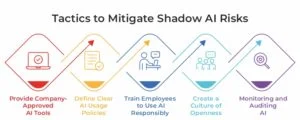Artificial intelligence is more than just a buzzword today. There’s no sector left where AI hasn’t marked its power. Let’s take a simple example of marketers who are driving good results by unleashing the potential of AI. How, you ask?
By utilizing AI tools, marketers can accomplish tasks more efficiently. Curate strategic campaigns, get creative content, images, ideation, plan, and more. Here, let’s mention our favorite AI chatbot, ChatGPT. With that being said, AI is here to automate tasks, drive productivity, and free up time to focus on what matters most. The same applies to other domains, such as manufacturing, healthcare, finance, and more.
But do you know, all things are on the good side! Moreover, there comes a growing challenge to shadow AI. Shadow AI occurs when employees use AI tools without their senior management’s knowledge or approval. According to Gartner’s report, Shadow AI stands as the top concern for risk leaders.
What is Shadow AI?
Shadow AI refers to the unauthorized use of artificial intelligence tools by employees, typically without oversight from IT or security departments. Employees may unintentionally put the company at serious risk in terms of security, compliance, and reputation, as IT professionals are often unaware that these apps are being used.
Sample Situations:
- To address an issue, a developer can insert proprietary code into ChatGPT.
- To gain insights on a campaign, a marketer enters consumer data into an analytics platform driven by artificial intelligence.
These actions, which may be intended to increase productivity, often occur outside of approved AI governance procedures, posing risks to security, compliance, and reputation.
Why Does Shadow AI Take Place?
Employees use Shadow AI for different reasons. Here we have mentioned a few:
Speed and Convenience: AI is known for its speed. Thus, employees can obtain immediate answers and solutions to complete their tasks, rather than spending time on manual efforts.
Lack of Official AI Solutions: Employees often seek AI alternatives if companies do not have approved tools.
Varying Knowledge of Risks – Many employees do not understand that by providing sensitive data to a public AI tool, they may be creating serious breach risk from a compliance perspective.
Often, employees are not acting with malice; they simply want to do their job more efficiently.
Impact of Shadow AI on Organizations
The recent release of large language models (LLMs), such as ChatGPT, has transformed productivity in the workplace. LLMs do not function like search engines, as they rely on prompt cues supplied by the user, which may include sensitive or proprietary business information.
There are four main risks of using AI-powered LLMS.
Data Leak: Any proprietary business data can be stored and/or processed outside of your ownership or control, and there is no guarantee that proprietary information won’t be stored in a vendor’s training dataset.
Compliance Violations: Sharing regulated data (e.g., privacy law compliance under GDPR, HIPAA, or CCPA) through ChatGPT or other AI tools can expose your business to potential fines that could be catastrophic.
Intellectual Property Loss: Any proprietary code, designs, and other trade secrets entered into a third-party AI application may mean that you are relinquishing ownership rights to that data, and may lose the ability to control who can borrow, copy, or own your data.
Brand Damage: Exposed sensitive data in the public sphere has the potential for substantial brand and reputational damage. There will always be a price to pay when sensitive information is publicly exposed. Your Brand Trust may never recover.
How to Mitigate Shadow AI Risks
The best approach to tackling Shadow AI is not restrictive bans, but structured governance that allows employees to benefit from AI while staying compliant.
1. Provide Company-Approved AI Tools
Employees often resort to Shadow AI when they are not provided with reliable, professional, and compliant tools. When businesses offer approved AI for both security and compliance, they decrease shadow AI usage.
2. Define Clear AI Usage Policies
- Clearly define AI-permitted tools or practices you prohibit.
- Clearly define the data types that are acceptable for AI inputs.
- Clearly define your data anonymization policies when using AI tools to ensure transparency and compliance.
- Revisit and revise as necessary, riding the crest of AI evolution.
3. Train Employees to Use AI Responsibly
- The most vigorous defense is awareness.
- The Risks of Entering Sensitive Information into AI Tools.
Examples of data breaches caused by irresponsible AI usage.
Being aware of your compliance and how AI can be adopted to support productivity while also adhering to those rules.
4. Create a Culture of Openness
Let employees share their AI needs and preferred tools, and enable an open dialogue with IT. The organization can better assess functional and safe AI solutions when employees work collaboratively with IT departments.
5. Monitoring and Auditing AI
Monitoring capabilities must be developed to detect and identify the use of unauthorized AI applications. Meanwhile, audits can help determine liability issues and trends, and address them before they become problems.
Moving to the Final Lines
Shadow AI is often the result of creating something from nothing, and it typically has no negative consequences outside of some potential liabilities. Most of the time, shadow AI is more an example of creative thinking rather than poor choices that lead to someone testifying in a lawsuit.
Remember, the objective is not to ban AI use, but to define how AI is used in a safe and compliant manner that reflects the organization’s strategies and statutory responsibilities.
When appropriately executed, AI will be a partner for employees rather than a risk.
Check out our blog section for all the insights around the tech world.
Recommended For You:
How Meta AI on Instagram Helps You Create Images, Modify Texts, And More


